Letters to Winckelmann (18th Century)

In the Spring of 1767,the twenty six year old JOHANN HERMANN VON RIEDESEL, Baron of Eisenbach set off from Naples. Riedesl would later be a diplomat at the Prussian Court of Frederick II. He traced the steps of ancient travellers, for a trip in space and time which would take him the coasts of the Magna Grecia, in the deep soth of Italy. | The project had long been planned with his friend Johann Joachim Winckelmann, a “father” of Neo classicism, but the architect was no longer able to leave, he was on the verge of finishing the writing of “Monumenti antichi inediti”(Unpublished antique monuments). However, Von Riedesel decides to leave alone but he continually writes to his friend of all he sees, beginning from his point of view, a man passionate about all which was old. These letters constitute the book called Travels through Sicily and that part of Italy formally called the Magna Grecia,the first neo classic journey in Italy. | 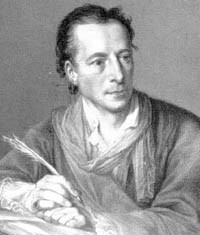
J.J.Winckelmann
| It is part of this itinerary which we would like to propose to you to follow, to trace the steps of this 17th century traveller, his thoughts and his emotions, discovering an different Adriatic, one which has remained intact over the centuries. From Sicily, and from Malta the baron took to the sea on a boat for Taranto, then for Gallipoli on the 23rd May 1767, where the crew of seven sailors were dismissed, and he continued his journey by land following the coast; “I made the journey from Gallipoli to Otranto (Hydruntum) on horseback, a journey of thirty six miles. Otranto is situated on the Adriatic sea, as you all know on the other side of Italy.” (pages 19-20). | 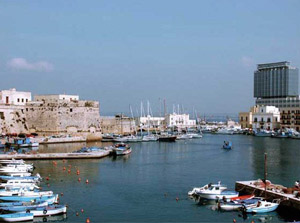
Gallipoli
| Our traveller stopped halfway; “ At the half way point, walking, in a place to rest the horses, there was a consecrated place to the devotion, called the Madonna di Scarnachia, a pious zeal which attracted a large crowd of pilgrims from all parts.” We would also like to propose to our Adriatic travellers a pleasurable stop, for a snack under a pergola, and a passionate search for Riedesel’s sanctuary which cannot be for certain identified. There are several places in the area, very interesting places to see and visit, in which anyone of them could be the place visited by the noble German. | | We suggest a visit to the following: - Santa Maria delle Grazie, a short distance from the Ionian coast; - Santa Maria della LIZZA (or dell’Alizza), situated on the site of the old Aletium; - Santa Maria della Cultura, in Paràbita; - Madonna della Campana; - Santa Maria della Croce; - Santa Maria della Strada; - And other minor churches and monasteries found in the area. The Baron was really taken by the fascinating melancholy of the ruins which were scattered along the route, and also the flora and all the activities of the place; “ Six miles from Otranto one can see the frequent and notable dress of the old roads . which had been built by the Romans, who had built from Taranto to Hydruntum…It is like the via Appia and like all the old roman roads, covered in large irregular stones ; right and left, one can see a number of tombs, which I would not have noticed if it had not been for their square shape, and rising above the floor of stones. All of the others , of different shapes; some round, some square, oblong allof them in ruin without any inscriptions. The countryside between Otranto and Gallipoli is fertile with olive trees and the pastures are well known, as is the wool and the quality of the sheep, which feed on a very dry land.” | 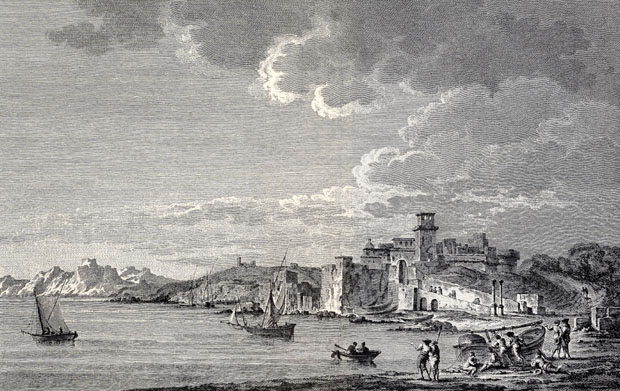
Otranto | . “the surrounding area of Otranto are delicious , there are many vineyards and gardens, the city is small, and does not even have three thousand souls.” Despite the fact that the population has somewhat grown , entering the city through the large door in the high walls, the historical centre of Otranto, with its narrow streets winding their way around the bastions of the castle and down towards the limpid blue of the sea, has preserved its size and balance, as once observed by Von Riedesel. The surrounding area offers the possibility of walking in the fields, along the excavated roads between the blackberry bushes and bulbous flowers, and the possibility of staying in delicious farmhouses , usually renovated old Masserie (old fortified houses). A few kilometres away , Porto Badisco, a tiny locality on the sea , offers a stupendous walk along the coast, in the direction of a ruined tower, and a cove with transparent water 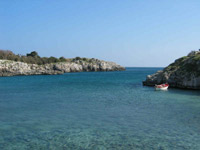 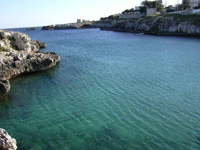 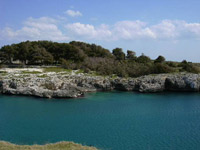
Porto Badisco Acrecerauniae horridos montes;
…vicina Ceraunia juxta
Unde iter Italiam, cursusque brevissimus undis. Regarding the vineyards, the enological production in Puglia in recent years has undergone a rapid improvement in quality, and its possible to find interesting local wines in the wine shops or you can visit the local cellars directly were some of the best wines of the area are produced. On a clear day it is possible to see from across the sea the mountains of Albania, which evoke memories of ancient western travellers who identified these outposts of Greece. “the mountains of Albania, separated by a channel of sixty miles Otranto, and are perennially covered with snow, can be seen clearly | 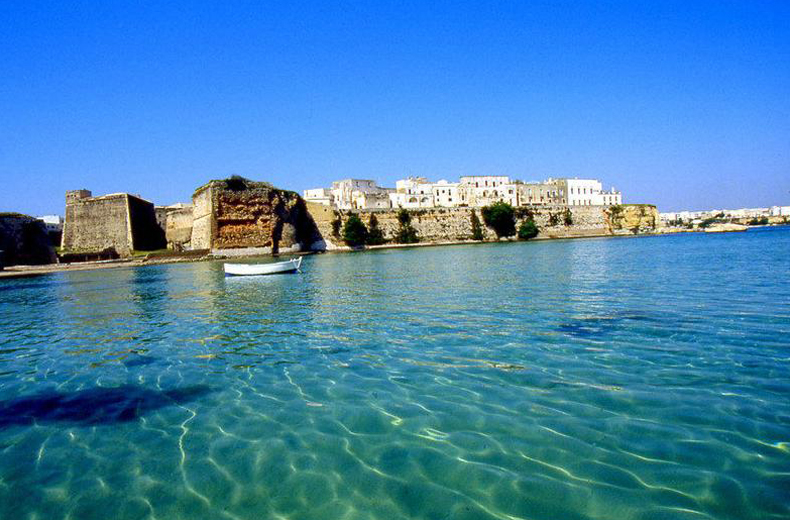
Otranto | This view of Greece, has given me a real desire to go, and if I found in my possession letters of recommendation and enough money, I would have embarked from Otranto.” In his description of, Otranto Riedesel tells Winckelmann about the cathedral, leaving out the exceptional example of mosaic found on the floor of the cathedral, stopping to describe with greater precision other architectural aspects; “The cathedral (the duomo) is a grand gothic building, supported by old granite and marble columns (different types of marble. Beyond the choir one can find an underground chapel which in itself is also supported by columns, smaller but at the same time beautiful, of different marbles too, yellowed by age, posing etc There are many beautiful capitals and out of all of them two took my notic, they have four bird shaped corners…” | 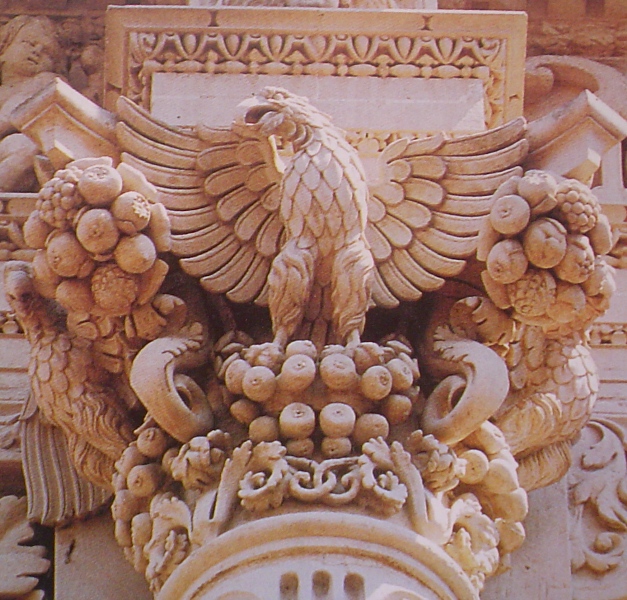
Lecce, particular of the church of S.Croce | Riedesel also noted, with interest, a square shaped tower, probably dating back to Roman times, next to the wall. The city descends arched around the sea, and its sea front is an uninterrupted succession of beaches with crystal clear waters. Riedesel then leaves for Lecce which he reaches after a day on horseback. “Along the way I recognised the continuation of Via Appia, which goes from Brindisi to Otranto one can see preserved fragments, right and left of ruined graves.” At a point halfway Martano attracted his attention, with its inhabitants of Greek origin , who preserved both the language and the customs, for its old medallions, and carved stone found not only on the outskirts but in all the villages along the road, immersed in the brightness of the deep south, the houses built of light coloured stone, scattered in the garden paths cultivated and representative of the unique atheistic characteristics found only in Salento. |
“ The villages between Otranto and Lecce are the most beautiful in all Italy; the churches and the houses are built in a white stone which is similar to the stone found in Malta, the land is very well cultivated and seems to be one long garden.” Even to the modern day travel interesting things can present themselves, if they take themselves in an inland direction, for example to Veglie, not very far from Lecce. 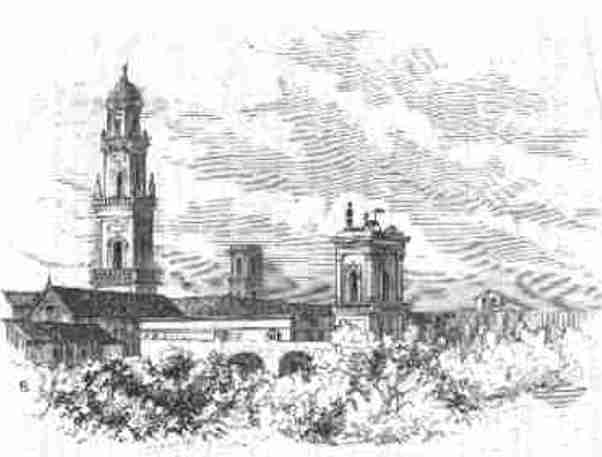
Lecce | Of Leccese architecture Von Riedesel plainly refused to acknowledge, according to the neoclassic canons, Baroque taste, which was only re-evaluated in the 19th century and he like all of those of his age defined it as “gothic”: “After Naples, Lecce is the biggest and most beautiful city of the realm.. Its streets are wide and well tiled, the churches, like the houses are built in a white stone, originating from here, found in caves, it is soft enough to decorate easily, as if it was made of wax…” | 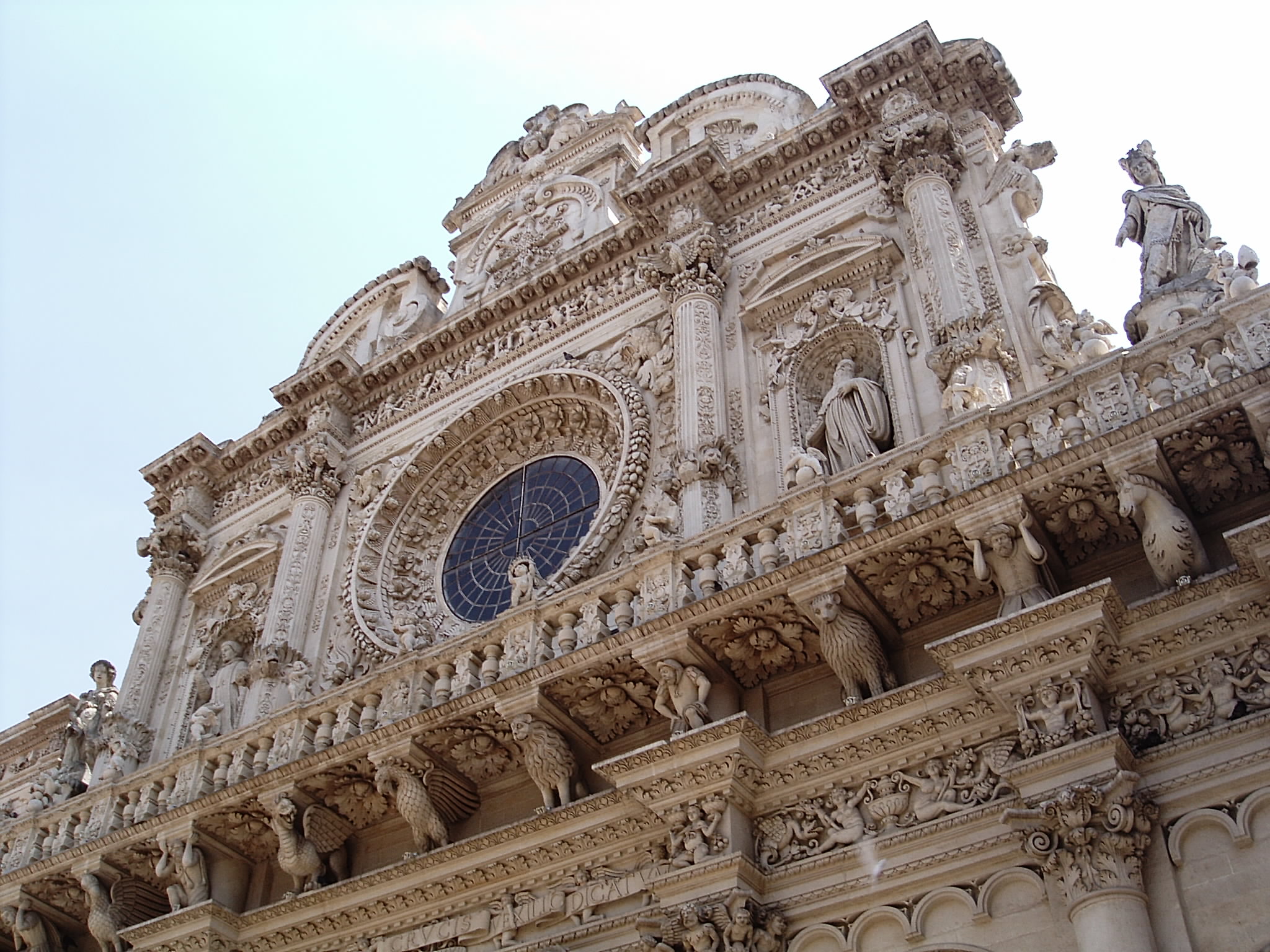
Lecce, Santa Croce | This stone as already mentioned is found throughout Salento, and is used for great buildings, elaborated and for many other things, even today it is the source of many crafts along with papier machè found in the craft shops in the historical centre of the city. Riedesel also wrote about the lace makers , with their products which adorned the façades of the churches and portraits found within. | During his stay in Lecce he visited the noble palaces of the city (which are still imposing sights of the city for example Palazzo Palmieri), above showing his appreciation of the grace and dancing skills of the ladies. However, it was Otranto that really holds all the surprises , for example the remains of an old church, only steps away from the castle, its ruins descending towards the sea, and a small Byzantine church, completely covered in frescos, dedicated to St Peter and Paul. Get to know the local academics, like Ortensio Leo, a passionate collector are carved stones, and who the library in Brindisi is named after. Here and in other manuscripts, in which the young German writes to his friend Winckelmann, in which Leo lists the monuments of the city and their dates. An interested traveller could look them up and use them as a guide through today’s city. 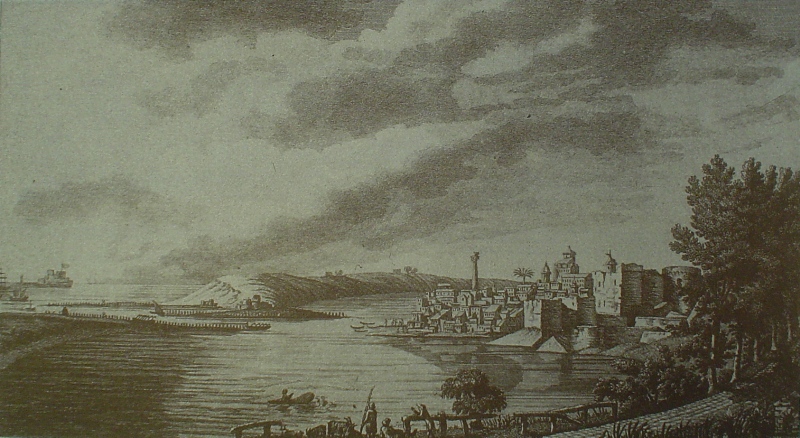
View of Brindisi Travelling once again, this time towards Brindisi, passing through villages along his route, the countryside covered with olive trees, he accosted the city across a 17th century filter, of the ruined aesthetics and the debates on its greatness and imperial decadence. The city lived, in his letters across a fascinating melancholy, a once densely populated port (then full of sand) to the ruins and old tombs. “From Brindisi was taken to Ostuni ,a small city of four thousand souls, situated on the top of a high mountain, from which there is a spectacular vie. Along the way one can see what is left of Via Traiana, and the ruins of tombs made of bricks.” | 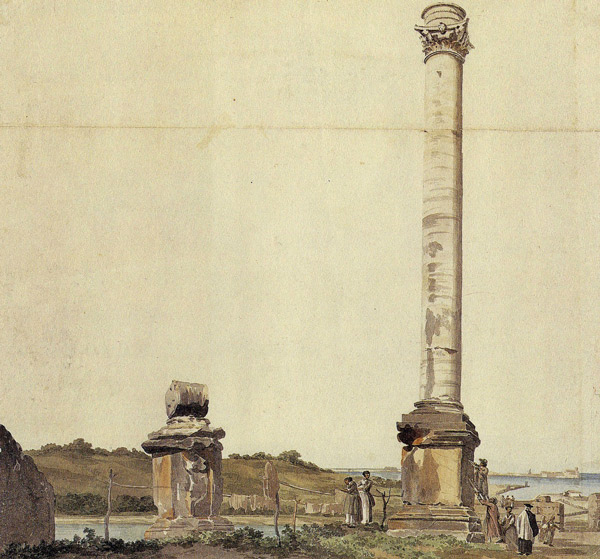
Brindisi, column at the end of Via Appia (Ducros)
Going towards the coast going inland one comes to, almost submerged in the marina, le Murge, layers of the Apennines, which offer their picturesque hamlets in the Summertime, after days spent at the seaside or days spent mushrooming in the Autumn.
| 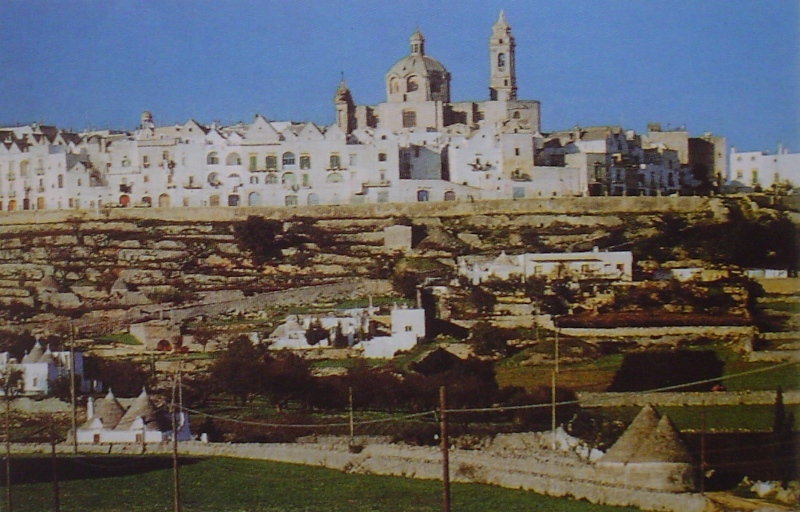
Locorotondo | In addition, Ostuni which rise on the hill, with its white walls, framed in olive groves , we can also suggest the area of Cisternino,Locorotondo and the entire Valley of Itria, which are all rich in traditional and cultural events. Great care has been taken with the description of the church of Santo Sepolcro, built on the remains of an old temple. | Dehinc Gnatia lymphis etc… (Horat. Sat. I, 5,67)”. 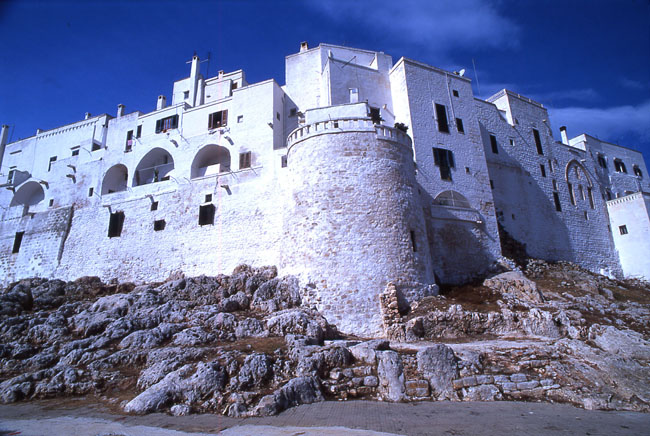
View of Ostuni “ From Ostuni to Monopoli one passed through olive woods and six miles from Monopoli one can find the ruins of the city of Egnatia: | The coast in these parts follows cliffs ands long stretches of gold, dunes and Mediterranean bushes/scrub (juniper, myrtle, lentiscus), from Villanova to Torre Canne, to Savelletri, to Capitolo, villages that have imposing farmhouses which have been converted to welcoming Bed and Breakfasts’ and Restaurants (it is also possible to rent cottages and villas for longer stays.) the surrounding land is well looked after even if it is agricultural providing a scenery for a painting, the colours vary depending on the season, or on the rotation of crops, from the red of the soil to the smokescreen of greens, fig trees, mulberry trees and prickly pear trees, and of course not forgetting olive trees which gives the area its identity. Along the coast, after Savelletri, one can find the remains of old Egnatia, searched for and discovered by a neo classic traveller, the reason why he travelled in the first place, the emotions and the knowledge that he could tell his old friend who had stayed in Rome; “One can still see the remains of its old wall…” From the ruins from the remaining stones, you could imagine what was missing, hypothesize about the buildings, the roads that made up the city. | 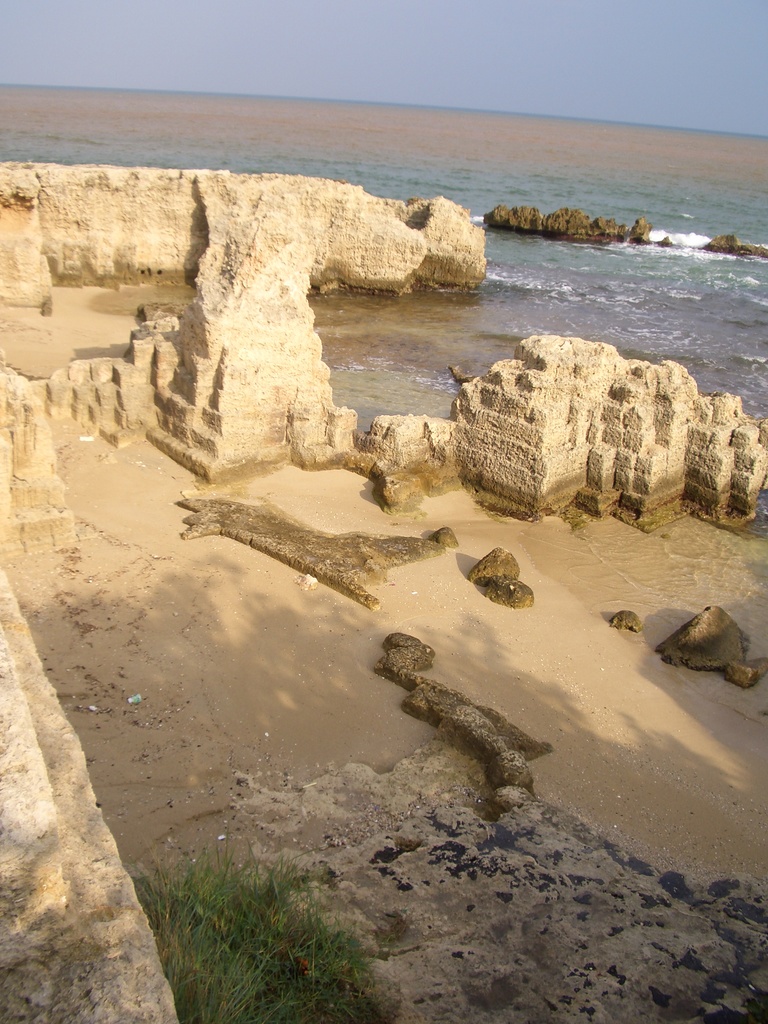
The sorrounding of Monopoli | Riedesel did not appreciate Monopoli which has a pleasing view from its port, old palaces and Charles V’s castle , from where one can start a walk along the sea front with its network of small and characteristic restaurants, on the sea and sheltered by the port, in small narrow roads of the old hamlet. However, with a new sensitivity for the picturesque, which was formed in those years, instead the Baron was aware of the attractiveness of the walk; “its surrounding areas are beautiful, with orange and lemon trees, its radius offers a pleasing sight for the eyes…” A year later Goethe would identify Italy as the “country where the lemon tree blossoms” and this is what travellers coming from the cold northern countries dream about, and it is in the south, this very same place where the myth becomes a reality. | 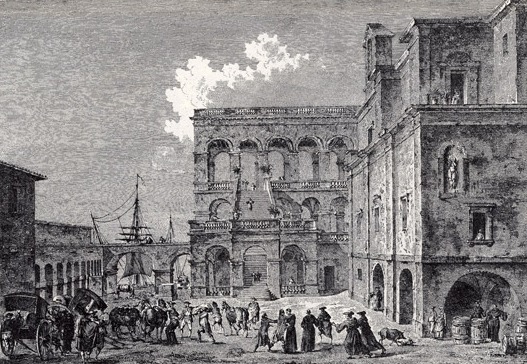
Abbey of S.Vito (Saint Non) The journey continues towards Polignano and Mola, “beautiful little towns”, in which many contemporary travellers also pause to look at, including the Abbey of Saint Non, which is mentioned in his “picturesque voyage” which contains some gashed incisions in the walls, to the grottos of the palatial Abbey San Vito, which overlooks the sea, and like in the 17th century it is still possible to eat tasty meals. Even today, the gardens of the masserie (fortified farmhouses) are enclosed by dry stone walls (horti conclusi),and the majority have citrus orchards, including those which have a mixture of huisache, jess amine, pomegranates, and fruit trees long disappeared from the markets, for example the sweet jujube tree,sorb apple trees, and others. | 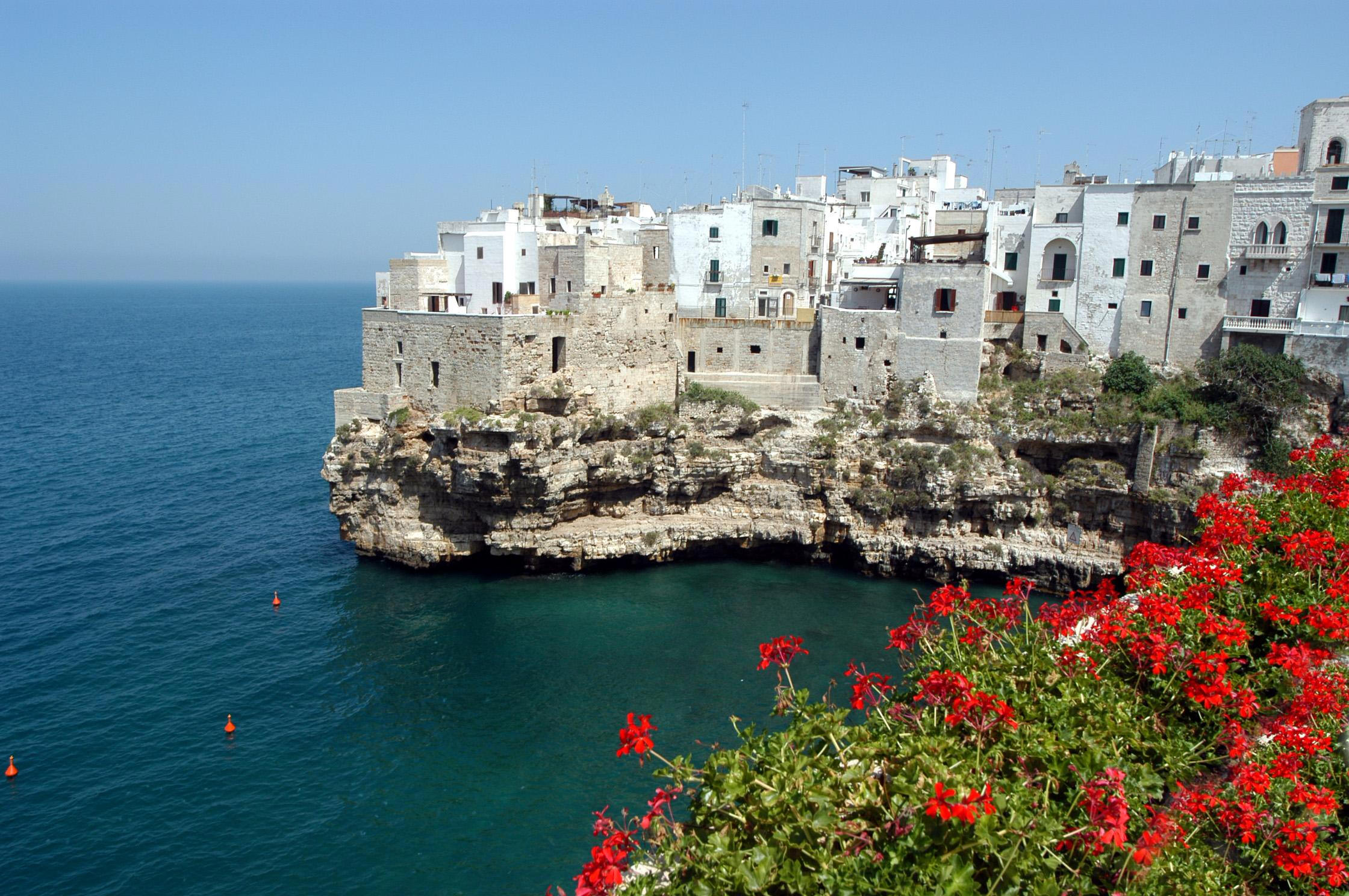
View of Polignano | Riedesel continued his journey towards Bari “The site of the city is one of the most beautiful, both the surrounding areas and the city itself, it is one of the more fertile, durum wheat, oil, wine, fish in abundance (Piscosi, moenia Bari, Horat)”. Riedesel is obviously referring to the Bari of old, a small peninsular on the sea, that has walks on the walls-the old walls of the seaside hamlet and the splendid basilica of San Nicola and many other Romanesque churches. The narrow winding streets where the women sat on their doorsteps and made pasta for the local dish “orecchiette”, to the Svevo Castle surrounded by a moat and gardens, offering an almost complete picture to the one seen by our traveller. | However the city underwent a development, the external part of the city is completely new, the walled hamlet (from Gioacchino Murat who was the King of Naples at the time, posed in stone) rising up at the beginning of the eighteenth century in an harmonious and rational urban plan. Also the brickwork, with its airy foundations of isolated squares, each with an internal garden , and its elegant two storey buildings,( whereas it was not spoiled too much by the building boom of the 1950s’and 60’s) it still offers pleasant walks amongst the elegant shops , mainly clothes shops. 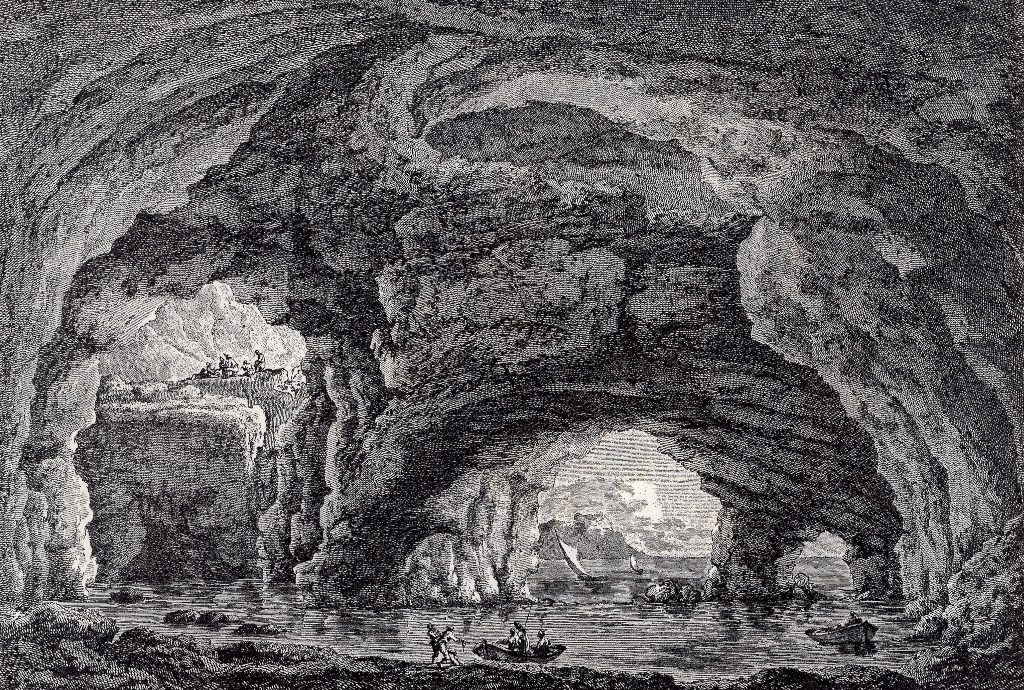
Grotta di Palazzo (Abate di Saint Non) Riedesel, always the good protestant allowed himself with subtle irony a blessing from the miraculous San Nicola, and he also gave full marks to Caravagian canvasses present in the church of Santa Chiara.
The Baron was able to meet in Bari collectors of vast antique vases “of a beautiful shape and perfect design” like that of the Canon Pedruzzi, aristocratic and illuminating the rapidity of the people, middle class, active and skilled businessmen, with a subtle intelligence. “A delicate genius”, “activity”, “industry” are the human qualities revealed in the city that I am about to leave,
“they work well with glass, they make when linen and cotton canvasses. Fino al caput mortuum non,wine which is not distilled, in the surrounding areas one can find an excellent moscato wine…”
The rational architecture found on the sea front was built during the twenty years evokes the rare atmosphere of the metaphysical painter De Chirico, and starting from the last few houses which descend on to a long beach almost reaching the next village. 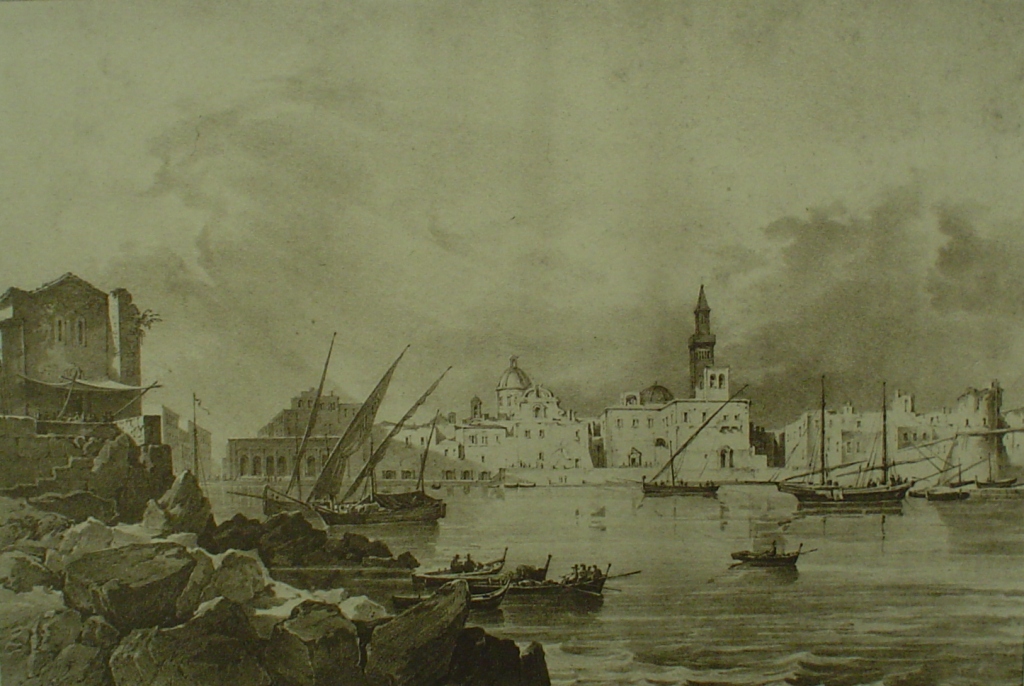
View of Bari The route continues towards Barletta; “From Bari one can go to Barletta for its beautiful and delicious streets.. In four and four miles one meets the small village and the surrounding countryside which is very cultivated. Giovinazzo, and Molfetta are both beautifully situated and most gracious…”
It was however, Bisceglie , which caught the attention of Riedesel, for the building which housed its old spa,
“before reaching Bisceglie, near the city, there are the old baths and spa, all very well preserved. To go in it is necessary to climb six small steps and then two steps under the water, steps which can be sat upon by the bathers taking the waters…”(pages 31-32).
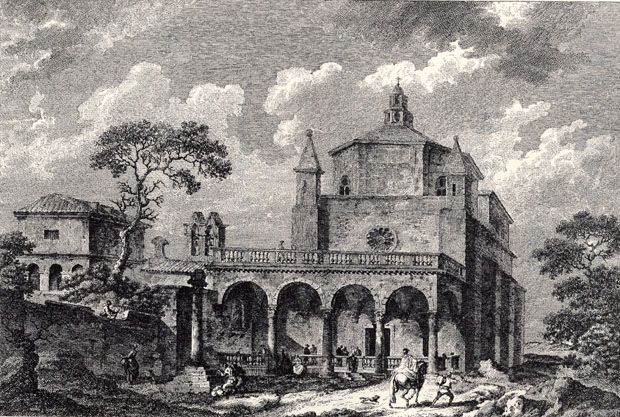
Barletta (Saint Non) In Bisceglie one can find old buildings in which one can discover nature, a game, a stimulating enigma even for today’s visitors, who can go even further back in history , visiting the dolmen in the Bisceglie countryside, found amongst the olive groves. | Six miles from Bisceglie, amongst the tombs and remains of Via Traiana, Riedesel reached Trani, “a small gracious city with much life” and for a street rich in the stone remains and old repositories of the old Roman road to Barletta, which appears as a “beautiful city” big and uninhabited. An anti catholic controversy was noted by the protestant Von Riedesel regarding the bronze statue of the Colossus; “I believe that the statue represents Julius Cesa, but , in Barletta they have thought to put an iron cross in his hand, so making him a Constantine.” | 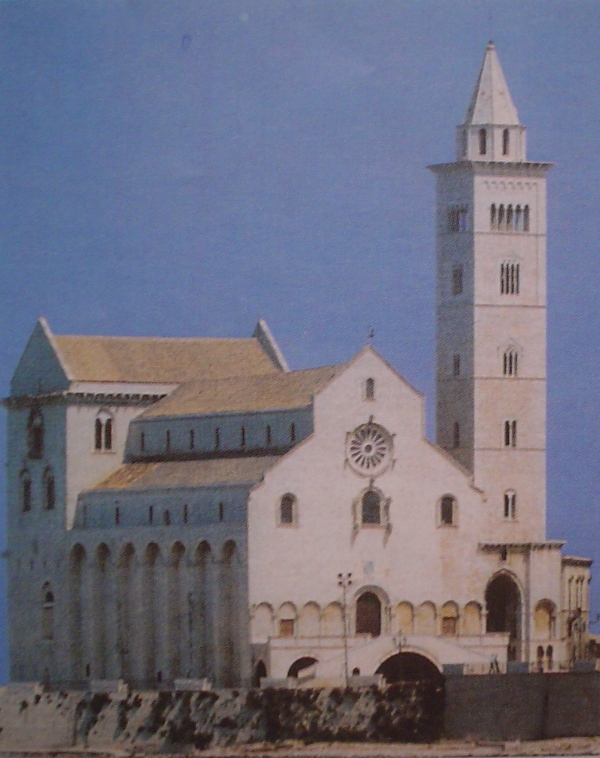
The cathedral of Trani | 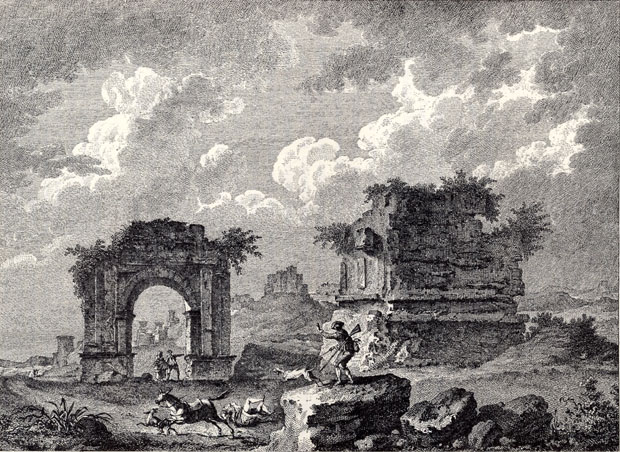
Canne (Saint Non) “going eight miles on one arrives from Barletta to Canne (Cannae). This city was built on two hills, in which even today passes a road. I found on the right hand hill , column inscribed…One can see a house and a temple half of the temple still exists. On the hill on the left hand side one can find another column which is much damaged. At the foot of this column there is an old nymphaeum, made in stone and square shaped, well preserved , with a fountain.. All around one can see walls of the old city. The battlefield is a vast plain which from what I can see is planted with barley and one can find working the earth pieces of arms and other weapons.” It is uncertain who the statue actually represents, but in any case the German visitor appreciated the beauty of the churches, something the modern visitor can do likewise. It was however the nearby battle field decisive in an old war and fascinating for the baron, | 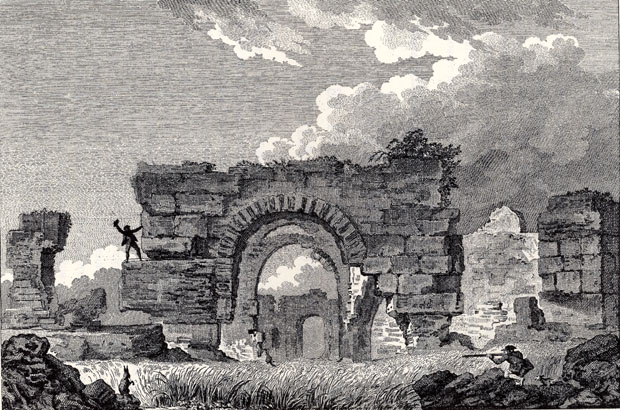
Canosa (Saint Non) | Continuing another seven miles and Von Riedesel crossed the bridge over the Ofanto a place between two old repositories, one in the form of a tower and the other which has its profile in the harsh landscape of the earth of the command and across an old triumph arch reaching Canosa, where one can individualise a another major bridge under which passed the old Via Appia in the direction of Ruvo, connecting Canosa and Bari through Ruvo (the old Rubbiae).
| This small town, preserves an old and interesting historical centre dominated by a Romanesque cathedral, noble palaces, in which there is that of Jatta, a small headquarters of (for its proportions not for its contents of works of art)a neo classic museum, founded by an old ancestor, a collector of antiques , ceramics, vases and objects of the area, scatterings of tombs ( from the 7th century to the present day). |
The fascinating thing about this museum , now open to the public, is that it has remained unchanged by time, it is exactly the same when it was founded at the beginning of the 18th century. In the same place it is possible to visit an old 18th century apartment, accurately furnished by the Jatta family, with an exhibition of historical clothes. | 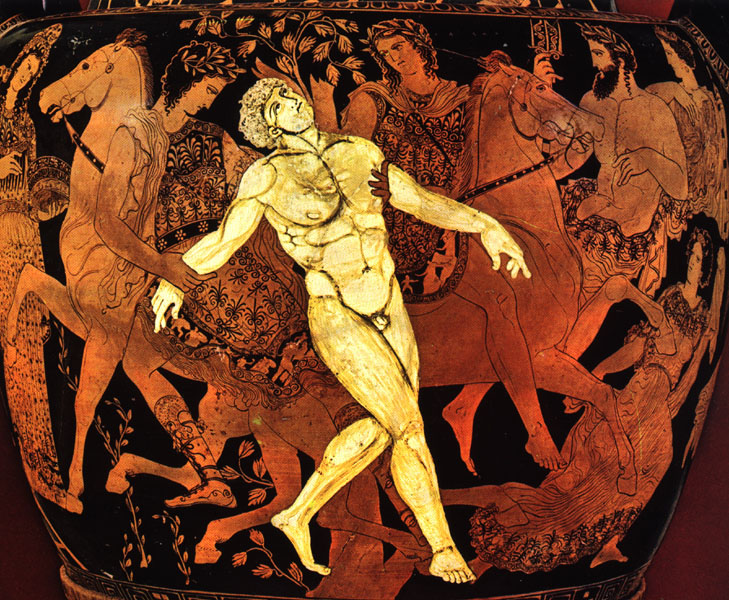
Collection of Jatta Museum | Following on from Canosa , reaching Cerignola Winckelmann’s friend, wrote about the rich archaeological discoveries , the old columns and inscriptions, and his suppositions on his journey, along the Via Appia retracing the triumph steps of the Traiano on their return from Dacia. 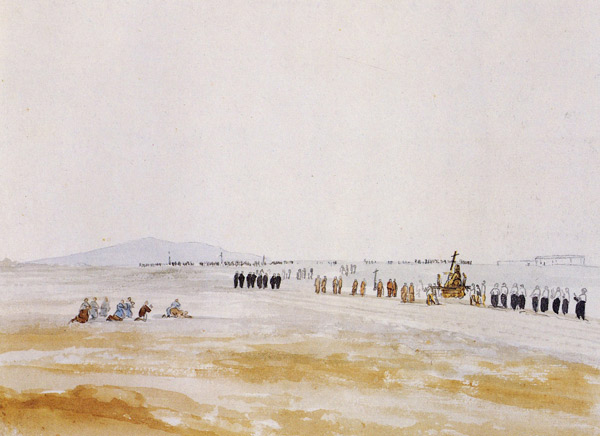
Cerignola (Ducros)
| On the border of Puglia across the Ordona, then an immense farmland belonging to the Jesuits, durum wheat, and oats, shining gold in the fields, called upon the sensitivity of the young baron, the relationship between the countryside and its ruins, we are in place of the ancient Herdonia, the remains scattered all around;
“on a small hill close by are the walls of a small city, of which I can recognise the port.”
A small temple, a place destined for sacred baths, remains of antique porticoes, catching sight of the holes in the floor witnessing the past amongst the growth of the wheat. The land of Puglia with its cultivated fields and “uncultivated land needed to put the buffalo to pasture…” remained at the back of the young German, as began his journey towards the bridge of Bovino. 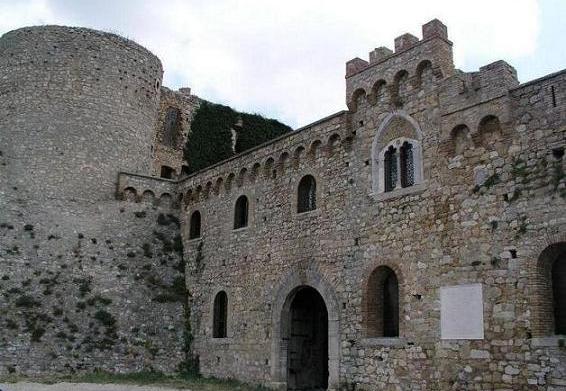
The castle of Bovino Not without stopping to discover and illuminate the interesting phenomena of the “tarantolati”, which are only minimally mentioned in his letters (pages 37-38). The modern traveller could do the same, especially witnessing the sights above all of Salento, where in the summer there are many events , especially the “pizzica” the typical folk dance deriving from the “tarantolati”. But this is not the best season for the journey, we advise you to travel in the tracks of Von Riedsel, excluding the hottest months, but to travel from March to January, when the mild climate and the sunny winter of the Puglian landscapes. | |
|
|
|

clicca sull'immagine per aprire la mappa attuale
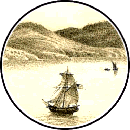 |
|